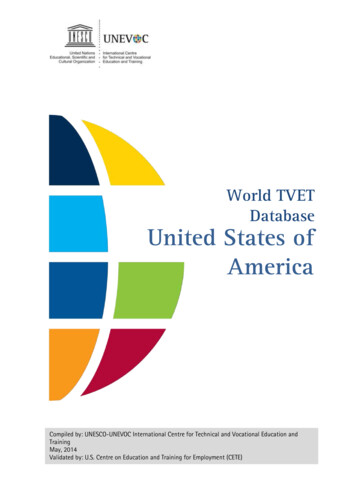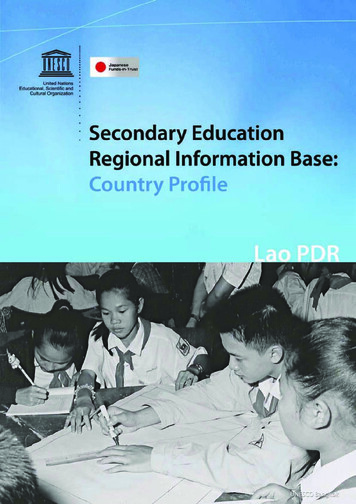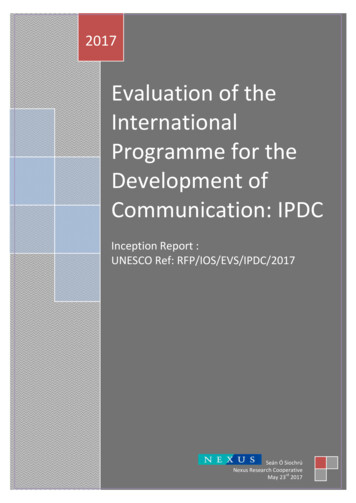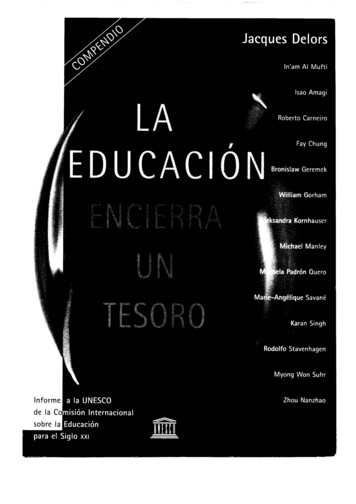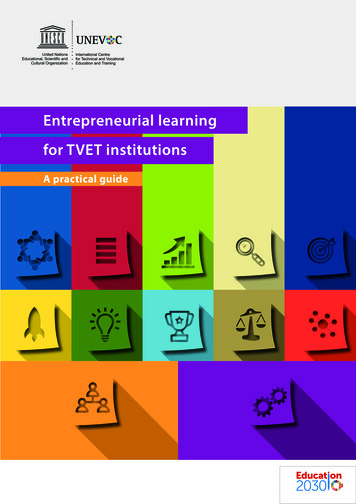
Transcription
TVET Country ProfilesJune 2020 LaoLao P.D.RJune 2020Compiled in collaboration with SEAMEO VOCTECH
TVET Country ProfilesJune 2020 Lao P.D.RContentsStatistics . 31. TVET systems . 42. TVET strategy and key policy documents . 63. Governance and financing . 84. TVET teachers and trainers . 95. Qualification system and quality assurance . 106. Current reforms and policy discussion . 117. References and further reading . 13TVETipedia GlossaryIn case of further clarification and definitions of terms contained herein, please refer toUNESCO-UNEVOC’s online TVETipedia Glossary, which provides definitions and backgroundinformation from various trustworthy sources on terms commonly used in the area of technicaland vocational education and training. Find out more at www.unevoc.unesco.org/l/68.AcknowledgementsThe following report has been compiled in collaboration with SEAMEO VOCTECH, and theMinistry of Education and Sports. Further details of the contents contained herein can be foundat the TVET Platform for South East Asia https://sea-vet.net/.UNEVOC Network in Lao PDRThe Vocational Education Development Institute represents Lao PDR in the UNEVOC Network.2
TVET Country ProfilesJune 2020 Lao P.D.RStatistics1General torTotal population2Population growth (annual %)2Median age of population2Population aged 15-24 years (%) 2Statistics16.3 million (2018)1.4 (2019)25.6 years (2020)17.8 (est 2019)GDP growth (annual %)3GDP per capita (current US ) 3Unemployment rate (%)4Youth literacy rate, population 15 years andabove, both sexes (%)2.3 (2020)1,510 (2018)0.67 (2019)92 (2015)Participation in education by level and by programme orientation (2018)CategoryGross enrolment ratioFemale (%)100.4Gross enrolment ratio (%)Primary education (ISCED 1)Lower secondarySecondary(ISCED 2)education, allUpper secondaryprogrammes(ISCED 3)Tertiary education, all programmes(ISCED 5-8)IndicatorPercentage of students in postsecondary non-tertiaryvocational education(ISCED 5)Percentage of students inVocational oth sexes (%)Students who are female (%)-40.7 (2017)-44.9Education financeCategoryExpenditureIndicatorExpenditure on education as % of totalgovernment expenditure (%)Statistics2.16 (2018)(Includes both operating and development expenditures)1Unless otherwise indicated, all statistics have been gathered from the UNESCO Institute for Statistics (UIS). http://uis.unesco.org/World Population Prospects UNDESA https://population.un.org/wpp/3 Asian Development Bank – Asian Development Outlook April 2020 https://www.adb.org/countries/4 ILO Estimates 2020 ilostat.ilo.org4 World Development Indicators data.worldbank.org23
TVET Country ProfilesJune 2020 Lao P.D.R1. TVET SystemsTVET in Lao P.D.R Education SystemTertiary (ISCED 5-8)DoctorateAt least 3 yearsMasters1-2 yearsBachelors DegreeBachelors4-5 years(Continuing Education)At least 1.5 yearsAssociate DiplomaTechnicalEducationDiploma2 yearsHigh TVETDiploma2 yearsPostsecondarynon-tertiary(ISCED 4)2-3 years regular1 -1.5 years Continuing EducationHigh TVETDiplomaRegularProgramme3 yearsUpper Secondary(ISCED 3)Vocational Education Diploma1 yearUpper Secondary GeneralEducation3 yearsIVET Certificate III (12 months)IVET Certificate II (At least 6 months)VocationalEducationCertificate3 yearsLowerSecondary(ISCED 2)Lower Secondary Education4-5 yearsPrimary(ISCED 1)IVET Certificate I (6 months)Primary education6 yearsGeneral educationCompulsory educationTVETEducation Pathway13 Compiledby UNESCO-UNEVOC International Centre. For a detailed overview and exact mobility between variousprogrammes, please see page 64
TVET Country ProfilesJune 2020 LaoEDUCATION SYSTEM LAOSource: https://sea-vet.net/lao
TVET Country ProfilesJune 2020 LaoFormal TVET systemThe formal TVET system in Lao PDR is structured as follows:TVET programmes are initially offered at the upper secondary education level (ISCED 3).Duration:Admission requirements:Taught in:3 yearsCompletion of lower secondary educationVocational Upper Secondary SchoolsAfter the completion of lower secondary education, students have the choice of continuingto upper secondary general education or of entering upper secondary vocational trainingprogrammes offered by the Ministry of Education and Sports (MoES). The students caneither complete three successive initial TVET Certification courses (Certificate I for 6 months,Certificate II for at least 6 months) and Certificate III(12 months), or they can access thelabour market after completing each certificate.Alternatively, the students can also enrol in a Vocational Education Certificate Course for aduration of 3 years.Technical and Vocational Diplomas are provided at the tertiary education level (ISCED 5).Duration:Admission requirements:Taught in:2-3 yearsCompletion of General Upper Secondary Education, VocationalUpper Secondary (Holding Certificate III), or the VocationalEducational DiplomaPolytechnics and Technical InstitutesThere are three main diplomas offered for the technical and vocational track at the tertiarylevel. The shortest transition track to the labour market is offered through the TechnicalEducation Diploma, which lasts for two years for students that have completed secondaryeducation or the Vocational Education Certification at ISCED 3.Students who have completed general upper secondary education can enrol in the HighTechnical and Vocational Education (TVET) Diploma in a regular cycle lasting 3 years.Alternatively, students who have completed the Vocational Education Diploma can alsoenrol in the High TVE Diploma, in a continuing education cycle lasting 1 year. Students whohave obtained a Vocational Education Certificate can also enrol in the Higher TVE Diplomafor a duration of 2 years before accessing the labour market.Non-formal TVET systemNon-formal TVET is implemented under the supervision of the Ministry of Education and Sportsin IVET schools and training centres. Vocational training is also offered at more than 300Community Learning Centres across the country. These offer short training courses on basicvocational skills in wood processing, construction, chicken, frog and fish raising, mushroomcultivation, cooking and beauty.The Ministry of Labour and Social Welfare also runs some skills development centres offeringshort and long term training courses in IT, auto repair, carpentry, furniture, garment,electronics, electricity, hospitality and construction, mainly for school drop-outs and unskilledadults. The number of these institutions and the enrolments are not known.
TVET Country ProfilesJune 2020 Lao P.D.RIn addition to the training schools and centres under the ministries, some private-sectorassociations and companies have their own training centres, and other SMEs provide trainingon their own premises. For instance, some handicraft SMEs provide workers with training inspecial and traditional weaving techniques. They have their own training facilities and haveexperts to provide the training. The training aims to improve the quality of the products.Previously, it was aimed at teaching people how to preserve their culture and heritage, andinvolved passing on the traditional expertise.2. TVET strategy and key policy documentsThe main strategy and policy documents guiding Lao P.D.R in the context of skills developmentand TVET are as follows:Name of documentNational TVET Development Plan 2016-2020Date entered into force2016Link not availableWebsite linkKey points and objectivesThe TVET Development Plan has been built based on specific guiding principles: Alignment with the TVET Strategy 2006-2020 but taking into account socioeconomic evolution in Lao PDR; Alignment with the 8th NSEDP (National Socioeconomic Development Plan) 20162020; and Alignment with the targets of the ESDP 2016-2020 (Education and Sports SectorDevelopment Plan).As part of this, the implementation actions include a focus on: Linkages to the economic and social priorities as well as national and local needsanalysis; Either a sectoral approach (examples: hospitality, financing, agriculture, garment,wood processing) or transversal approach (curriculum development, qualificationsystem) but with applications through pilot projects and subsequentdissemination; Various financing sources: government, private sector, foreign donors andinternational organizations, and individuals when possible; Involvement of the Provinces for increasing roles in the local implementation ofTVET schemes and better alignment with Department of Technical and VocationalEducation (DTVE); Adaptation of the TVET system to the needs of employers based on labour marketinformation system and in the absence of it, based on: signals from employers gathered by the National Training Council (NTC) andstrengthened Trade Working Groups (TWGs); Improved relations between the management of the TVET schools and provincialstakeholders; and Information from tracer studies. Increased focus on learning outcomes through dissemination of competency basedtraining, DCT; and Focus on high demand sectors: construction, mechanics, hospitality, electricity,furniture, automotive and agriculture.7
TVET Country ProfilesJune 2020 Name of documentLao P.D.RLao Education and Sports Sector Development Plan2016-20202016Date entered into forcehttps://t1p.de/t0zoWebsite linkKey points and objectivesThe Education Development Plan was developed with the overarching objective of buildingon and reinforcing the policies and strategies of the government to enable the Lao PDR tobe eligible to graduate from the ranks of the least developed countries by 2020. In doing so,particularly in the context of TVET, the ESDP has two main objectives: To encourage more students who have completed general education to enrol invocational education To ensure that vocational graduates from both public and private sectors haveskills that are acceptable to employers.To achieve these objectives, the ESDP targets: Establishing at least one technical centre and vocational school in each province. Expanding vocational education and training access to reach 60% of students whohave completed general education, especially females.There are three main strategic actions that are pursued under this strategy. These include: Strengthening vocational education schools/vocational training centres as well asproviding learning equipment for good teaching-learning, and offering courses thatare responding to industrial requirements;Fostering partnerships between the public and private sectors in vocationaleducation and training development through sector councils and career groupunits;Upgrading educational qualifications for vocational education teachers and staffin both quantity and quality, to improve their pedagogical competencies to teachin the relevant fields.3. Governance and financingGovernanceThe TVET Development Plan (Technical and Vocational Education and Training DevelopmentPlan 2016-2020 is implemented by TVET institutions managed by the Department of Technicaland Vocational Education (DTVE) in partnership with other organizations, particularly theMoLSW and Center for Education Quality Assurance of the MoES.Decree No. 036 on Technical and Vocational Education and Training and Skills Development,the current legal reference for TVET, distinguishes between the functions of the MoES,responsible for TVET, and the MoLSW, responsible for skills development, certification, andtesting. By separating TVET and skills development, however, the decree has led to someconfusion and duplication of efforts, with, for example, the two ministries working ondeveloping standards for the same occupation (ILO 2016, p. 12).8
TVET Country ProfilesJune 2020 Lao P.D.RThe current legislation distinguishes between short-term skills development training (less than12 months) falling under MoLSW jurisdiction; and continuous training of more than 12 months,called TVET, which falls under MoES jurisdiction. The two ministries are, therefore, the maindepartments in charge of TVET in the country. However, some skills development andvocational training is also provided under other line ministries such as the Ministry of Industryand Commerce (MoIC) and the Ministry of Health (MoH). (ILO 2016, p. 15).The National Training Council (NTC) is an inter-ministerial organization and tripartite body with35 members including representatives of youth, women, unions, employers, and differentministries. Its main constituents are the MoES, MoLSW, and Lao National Chamber ofCommerce and Industry (LNCCI). Its president is from the MoES, and its vice-presidents are thevice-minister of Labour and the president of the LNCCI. The NTC’s members are not technicalexperts but rather high-level representatives. The NTC’s budget (for salaries, equipment, andother items) comes from the MoES, but its mandate is above the MoES. The NTC is the umbrellaorganization for all TVET in the Lao People’s Democratic Republic, and it plays the role of anadvisory body regarding skills development issues. (ILO 2016, p. 15)Public-Private PartnershipCurrently, public-private partnership in TVET is being achieved through two modalities. One isthe participation of employers in policy-making and implementation, mainly through theNational Training Council (NTC) and Trade Working Groups (TWGs). The other modality involvesthe supply of TVET by private providers.Most employers in Lao PDR are small and medium-sized businesses. Except for in a fewbooming industries such as mining and hydropower, a large number of employers are stillrelying on recruiting unskilled workers. Thus, it cannot be said that there is currently a strongemployer interest in skills development.Associations in the garment, furniture, handicraft and hospitality sectors have established theirown skills development centers. For example, the Skills Development Centre of the LaoGarment Industry Association provides short courses of up to 35 days to workers following theASEAN Common Competence Program (ACCP) developed by the ASEAN Federation of TextileIndustries and using industrial equipment.FinancingThe overall share of TVET within the MoES budget was planned to double from 2.7% in 2015/16to 4% in 2019/2020. The budget for TVET increased mainly due to the high cost of equipment.Lao TVET development is still dependent on foreign assistance, although the Education andSports Sector Development Plan (ESDP) noted that the current international assistance for TVETis already relatively high in comparison to the assistance pledged to other education subsectors(12%). TVET donors support in order to improve the infrastructure and system elements, aswell as build sustainable capacity.4. TVET teachers and trainersCandidates for a pre-service teacher training programme apply at VEDI, which will send theapplication to all TVET institutions. These, along with the provincial authorities, select the9
TVET Country ProfilesJune 2020 Lao P.D.Rappropriate candidates and submit their appraisal to the ministry department for approval.Approved candidates can then be enrolled in the programme.After completion of the teacher training programme, the graduated teachers go back to theTVET institution they were selected by before. For in-service courses announced by the VEDI,the TVET institutions can select and nominate candidates.Formal requirements as set out by a government decree are not directly linked with a teachertraining degree. Rather, the decree stipulates that the candidate must possess a certificate atleast one level higher than the level of the course to be taught. Within this frame, types ofqualifications are considered in the context of the needs of the TVET institution.Responsibility for pre- and in-service teacher training is in a phase of transition. In the past,there were some specialized TVET institutions (mainly colleges) offering programs in areas suchas Hotel and Tourism, Construction and Agriculture, Automotive and Electric, Accounting,Mining, etc. Currently, the Vocational Education Development Institute (VEDI) at Faculty ofEngineering of the National University of Lao PDR will be responsible for both pre- and inservice teacher training. VEDI will then be in charge of curriculum development andcertification. Quality assurance is overseen by the Education Quality Assurance Center (EQAC),which was established by the Ministry of Education and Sports.5. Qualification system and quality assuranceA national qualifications framework (NQF) is currently under development, with the mostrecent draft proposing an 8 level structure.As stated in Section 1, there are a wide range of formal, non-formal and informal curricula,certificates and diplomas available from many institutions and organizations. Some are forshort courses varying from one week to one year. Others are for skills development coursesoffered under the Ministry of Labour and Social Welfare (MLSW), Dual Cooperative Training(DCT) and other vocational and technical courses. Employers, training institutions, students,and parents do not have any reliable way of assessing the value of any given certificate forinstance their value in terms of personal ability to do the job or proceed to further levels ofeducation.Quality assuranceThe quality assurance system for TVET institutions including standards, procedures and trainingmodel has been developed and implemented gradually through self-assessment reports andinternal assessment. It is managed by the Center for Education Quality Assurance (CEQA) andincludes 10 standards and 42 indicators. Workshops on quality for TVET institutions andassessors trainings are regularly held.CEQA is the leading organization supporting quality improvement in the education sector. Itscapacity has increased from 9 to 25 staff in 3 years but the scope of its work is very broad andcovers all education institutions in Laos PDR. The ’Quality Assurance Manual for TVETInstitutions’ provides a basis for improvement of TVET institutions and it is used in TVET sector,particularly when it comes to supporting the preparation of school development plans.10
TVET Country ProfilesJune 2020 Lao P.D.RSchools regularly prepare development plans for 3 or 5 year periods, but the templates usedare not consistent. There is an overall perception that training offered by the school is notgeared towards the needs of provincial economies. Strengthening TVET (STVET) and VocationalEducation in Laos (VELA) projects will support the development and implementation of planstaking into account the local context and skill needs of the provinces.6. Current reforms and policy discussionFollowing the Technical and Vocational Education and Training Development Plan 2016-2020,actions implemented should be based on: Linkages to the economic and social priorities as well as national and local needsanalysis; Either a sector approach (examples: hospitality, financing, agriculture, garment, woodprocessing) or transversal approach (curriculum development, qualification system)but with applications through pilot projects and subsequent dissemination; Various financing sources: government, private sector, foreign donors andinternational organizations, and individuals when possible; Involvement of the Provinces for increasing roles in the local implementation of TVETschemes and better alignment with Department of Technical and VocationalEducation (DTVE); Adaptation of the TVET system to the needs of employers based on labour marketinformation system and in the absence of it, based on:o signals from employers gathered by the National Training Council (NTC) andstrengthened Trade Working Groups (TWGs);o Improved relations between the management of the TVET schools andprovincial stakeholders; ando Information from tracer studies. Focus on high demand sectors: construction, mechanics, hospitality, electricity,furniture, automotive and agriculture.Based on the TVET Strategy and Master Plan, training providers are encouraged to targetseveral groups, including new labour market entrants (school leavers), existing workers, youngpeople, older adults, and disadvantaged groups (e.g. the poor, the populations of remote ruralareas, and ethnic groups). The government is providing incentives for disadvantaged groups toparticipate in TVET, through voucher schemes and scholarships.ChallengesAccording to the SEAMEO-VOCTECH, the key challenges facing TVET in Lao PDR are as follows:Low investment andsupport in TVETAbsence of suitable financing assistance schemes for TVET.Insufficient financial support to improve TVET school’sinfrastructure and facilities to accommodate increased numberof trainees and students.Persisting skillsmismatchesMismatching between TVET students produced and labourmarket demand and needs, thus highlighting insufficientintegration of TVET with market needs. This is also a result of11
TVET Country ProfilesJune 2020 Lao P.D.Rthe insufficient training materials and out-of-date machines andtools for practical training of students. The low quality oftraining (due to poor quality of infrastructure, machines andequipment) and inadequacies of the teaching staff who lackteaching skills and industrial experiences also perpetuates theskills mismatches.Limited appeal of TVETvis-à-vis generaleducationSome people value only higher education (university) whichcauses the low enrolment in TVET. Structured guidance tostudents on the learning opportunities and the prospects ofTVET is also limited.12
TVET Country ProfilesJune 2020 Lao P.D.R7. References and further readingBohlmann (2013): Current situation of the TVET sector in Lao PDR with special emphasison the education of vocational tuation TVET-Sector Lao PDR-2013-11-12GIZ (2014): Vocational Education in Laos ocational-education-laos.pdfILO (2016): Compilation of assessment studies on technical vocational education andtraining (TVET) Lao People’s Democratic Republic, Mongolia, the Philippines, Thailand /---asia/---robangkok/documents/publication/wcms 458131.pdfLateef (n.d.): Lao PDR Strengthening Technical and Vocational Education and TrainingProject (Gender Action Plan): teef.pdfMinistry of Education and Sports (MoES) (2015): Technical and Vocational Education andTrainingDevelopmentPlan2016-2020;from .pdfSEAMEO VOCTECH Regional Centre Brunei Darussalam (2015): Technical and VocationalEducation and Training in Lao PDR; from http://seatvet.seameo.org/docs/TVET Lao%20PDR 2015.pdfUNESCO(2013):PolicyReviewPDR 6E.pdfofTVETinLao13
TVET Country ProfilesJune 2020Compiled by Lao P.D.RUNESCO-UNEVOC International Centre forTechnical and Vocational Education and TrainingUN CampusPlatz der Vereinten Nationen 153113 BonnGermanySEAMEO-VOCTECH Regional CentreJalan Pasar Baharu,Gadong BE1318.Brunei DarussalamContactTel: 49 228 815 0100Fax: 49 228 815 o.orgThis publication is available in Open Access under the Attribution-ShareAlike 3.0 IGO (CC-BY-SA3.0 IGO) license /). By usingthe content of this publication, the users accept to be bound by the terms of use of the UNESCOOpen Access Repository a-en).Country profiles are compiled from a variety of national and international sources and havebeen informed and validated by UNEVOC Centres in the country or other TVET nationalauthorities. This report is subject to revision as deemed necessary by UNESCO-UNEVOC toensure consistency and accuracy of the details contained herein.The designations employed and the presentations of material throughout this report do notimply the expression of any opinion whatsoever on the part of UNESCO concerning the legalstatus of any country, territory, city or area or of its authorities, or concerning the delimitationof its frontiers or boundaries. UNESCO 2020All rights reserved14
in IVET schools and training centres. Vocational training is also offered at more than 300 Community Learning Centres across the country. These offer short training courses on basic vocational skills in wood processing, construction, chicken, frog and fish raising, mushroom cultivation, cooking and beauty.
